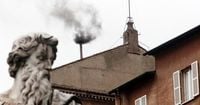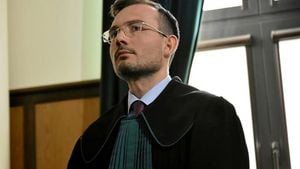On May 7, 2025, the conclave to elect the 267th Pope of the Roman Catholic Church commenced, following the death of Pope Francis last month. As the 133 Cardinals gathered in the Sistine Chapel, the anticipation was palpable, but the first round of voting resulted in black smoke emerging from the chimney, indicating that no consensus had been reached.
The conclave began its first ballot shortly after 1 p.m. ET, or 7 p.m. local time in Rome. According to the rules of the election, a two-thirds majority is required to elect a new pontiff. If the Cardinals fail to achieve this majority, further rounds of voting will take place, with up to four ballots conducted each day until a new leader is chosen.
As the Cardinals took their oaths of secrecy, they were sealed within the chapel, cut off from the outside world until a new pope is elected. The black smoke signals that the Cardinals have not yet reached a decision, and they will reconvene for additional voting sessions in the following days.
In 2013, the election of Pope Francis, born Jorge Mario Bergoglio, took just two days of voting. Given the history of papal conclaves, the expectation is that the process could be lengthy, as the Cardinals deliberate on the future direction of the Church.
Vatican Media is closely covering the event, providing live updates and in-depth reports on the proceedings. The day began with the “Missa pro eligendo Romano Pontifice” at St. Peter’s Basilica, which was broadcast in 11 languages, including English, Italian, and Spanish, along with Spanish Sign Language. This liturgy set the tone for the conclave, emphasizing the solemnity of the occasion.
Following the Mass, at 4:30 PM local time, the Cardinals entered the conclave, marking the official start of the voting process. The anticipation for the white smoke, which signals the election of a new pope, is high among the faithful and observers alike. Each round of voting will be followed by smoke signals from the chapel, with the next expected signs of smoke around 4:30 a.m. ET or 10:30 a.m. in Rome on subsequent days.
As the voting continues, the Vatican has set up extensive media coverage to document the process. Vatican News and Vatican Radio will provide daily live updates, capturing the results of each ballot and the corresponding smoke signals. If a new pope is elected, live reporting will expand to include commentary in Arabic and Vietnamese, as well as sign language interpretation.
The Vatican has also announced that L’Osservatore Romano will publish a special edition immediately following the appearance of white smoke, which will be distributed for free in St. Peter’s Square. This highlights the significance of the event, as the election of a new pope is a momentous occasion for Catholics around the world.
In recent history, the process of electing a new pontiff has garnered significant attention, with millions of viewers tuning in to witness the momentous event. The last conclave in 2013 was marked by the historic election of Pope Francis, who has since become a prominent figure in global discussions on faith, social justice, and the role of the Church in contemporary society.
As the Cardinals continue their deliberations, the world watches closely, awaiting the moment when white smoke will rise from the chimney of the Sistine Chapel. This will signal not only the election of a new leader for the Catholic Church but also the beginning of a new chapter in its history.
The process of electing a pope is steeped in tradition, with the smoke signals serving as a visual representation of the Cardinals' progress. Black smoke indicates that a decision has not yet been made, while white smoke will indicate a successful election. The anticipation surrounding these signals is part of what makes the conclave a unique and engaging event for both the faithful and those curious about the workings of the Catholic Church.
As the days progress, the conclave will continue to hold votes until a new pontiff is chosen. The world awaits the outcome, with hopes that the next leader will guide the Church through its challenges and inspire a new generation of followers.
The conclave is not just a process of electing a new pope; it is a moment of reflection and prayer for Catholics worldwide. Each Cardinal carries the weight of their decision, knowing that their choice will shape the future of the Church. The significance of this moment cannot be understated, as the new pope will inherit a legacy and face the challenges of leading a diverse and global congregation.
In the coming days, as more rounds of voting take place, the world will remain vigilant for the signs of smoke from the Sistine Chapel. The hope for white smoke remains strong, as people around the globe pray for guidance and wisdom in the selection of the next leader of the Catholic Church.




